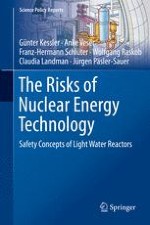2014 | OriginalPaper | Buchkapitel
10. Assessment of Risk Studies and Severe Nuclear Accidents
verfasst von : Günter Kessler, Anke Veser
Erschienen in: The Risks of Nuclear Energy Technology
Verlag: Springer Berlin Heidelberg
Aktivieren Sie unsere intelligente Suche, um passende Fachinhalte oder Patente zu finden.
Wählen Sie Textabschnitte aus um mit Künstlicher Intelligenz passenden Patente zu finden. powered by
Markieren Sie Textabschnitte, um KI-gestützt weitere passende Inhalte zu finden. powered by
Abstract
-
A large scale steam explosion in the reactor pressure vessel of a PWR would not jeopardize the mechanical integrity of the reactor pressure vessel. Consequently a steam explosion followed by failure of the integrity of the reactor pressure vessel and of the containment as assumed in WASH-1400 and the German Risk study can be considered impossible.
-
A large scale hydrogen detonation after core melt in the spherical containment of a KWU PWR-1300 reactor plant cannot jeopardize the integrity of the steel containment. Nevertheless hydrogen recombiners in the containment are useful for preventing or mitigating some accident sequences.
-
Core melt down after a break of a pipe of the residual heat removal system in the annulus of the containment system or core melt down after an uncontrolled large scale steam generator tube break can be avoided by proper design.
-
Containment failure after core melt down under high primary coolant pressure, as assumed in WASH-1400 and the German risk study, can be avoided by manual or automatic opening of pressure relief valves (ADS systems of Chap. 3) or—as a limiting case—reinforced anchorage of the pressure vessel cover.
-
Core melting through the bottom part of the reactor pressure vessel can be counteracted by flooding the reactor pressure vessel on the outside with water (severe accident measure). Similar results can be obtained by installing a molten core spreading and cooling device (core catcher). Appropriate core catcher designs were developed after research.
-
A rising steam pressure in the inner containment after a core melt can be avoided by water spray systems.
-
A mechanically intact double containment, where the inner containment is either a steel containment or a concrete containment with an inner steel liner, having a leak rate of 0.3–1 % per day after a core melt accident and where the leaking radioactive gases and aerosols are passed from the annulus through aerosol filters to a stack can fulfill the requirements of the KHE safety concept. In this case the contamination by radioactive fission products is essentially limited to the site of the reactor plant. No evacuation of the population is necessary.
